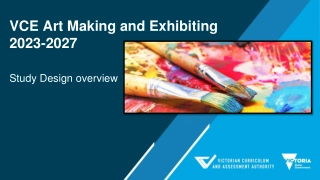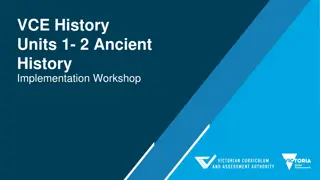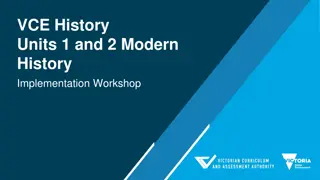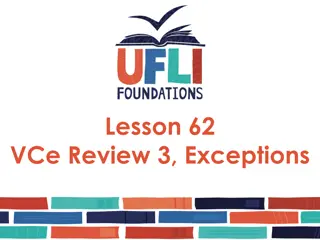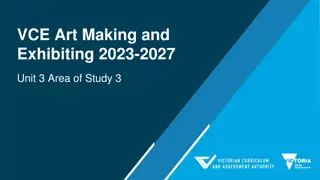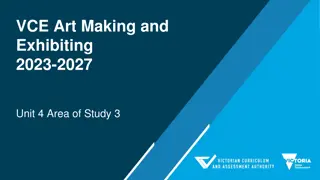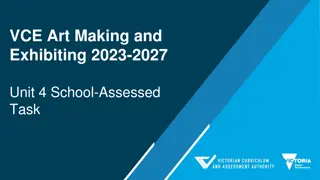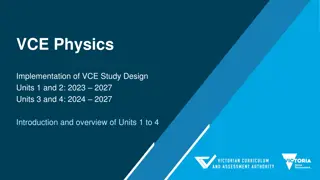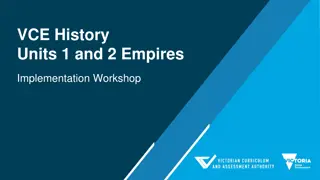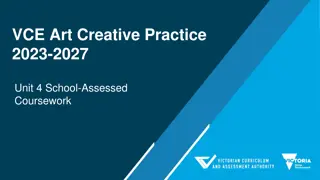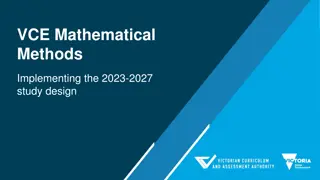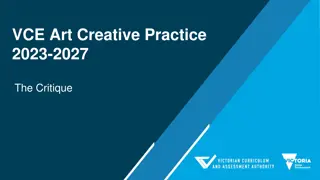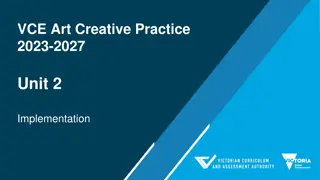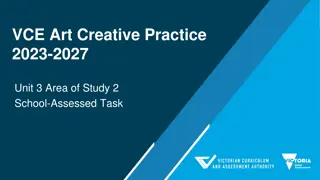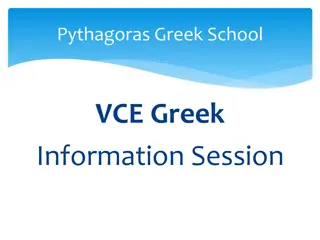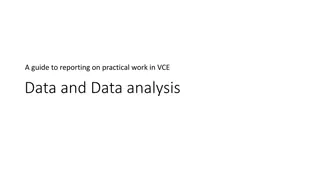VCE Art Making and Exhibiting 2023-2027: Study Specifications Overview
Delve into the world of VCE Art Making and Exhibiting with a comprehensive study specifications overview. Explore various aspects including creating artworks, exhibiting them, planning exhibitions, curation, conservation, and more. Understand the processes involved in making and presenting art, and gain insights into the visual language, techniques, materials, and aesthetic qualities essential for successful artistic endeavors.
Download Presentation

Please find below an Image/Link to download the presentation.
The content on the website is provided AS IS for your information and personal use only. It may not be sold, licensed, or shared on other websites without obtaining consent from the author.If you encounter any issues during the download, it is possible that the publisher has removed the file from their server.
You are allowed to download the files provided on this website for personal or commercial use, subject to the condition that they are used lawfully. All files are the property of their respective owners.
The content on the website is provided AS IS for your information and personal use only. It may not be sold, licensed, or shared on other websites without obtaining consent from the author.
E N D
Presentation Transcript
VCE Art Making and Exhibiting 2023-2027 Unit 3 School-Assessed Task
VCE Art Making and Exhibiting Unit 3 School-assessed Task Outline Features of Art Making and Exhibiting Overview of Unit 3 Area of Study 1 and 2 Teaching ideas Unit 3 Area of Study 1 and 2 Assessment ideas School-assessed Task
VCE Art Making and Exhibiting Study specifications Explore Expand Investigate Understand Develop Resolve Collect Extend Connect Consolidate Present Conserve
VCE Art Making and Exhibiting Study specifications: Making artworks Explore Expand Investigate Understand Develop Resolve Collect Extend Connect Consolidate Present Conserve Artforms Ideas and meaning Techniques Making artworks Visual Language Processes Art elements and Art Principles Materials Aesthetic qualities
VCE Art Making and Exhibiting Study specifications: Exhibiting artworks Planning and producing the layout and design of the exhibition and planning the flow of the exhibition, including sight lines, spatial relationships, viewer interaction and interpretation. Includes the creation of display furniture, selection of fixtures and use of lighting. Exhibition design Determining the theme or story to be told in an exhibition. Curation includes the selection of artworks, writing the introduction to the exhibition, deciding where artworks will be placed, the designing of viewer interaction and interpretation, and the preparation of condition reports of artworks. Curation Planning, organising and undertaking the preservation and conservation of materials and objects in private, public and community collections, including art galleries, museums, other exhibition spaces and site-specific spaces. Conservation
VCE Art Making and Exhibiting Study specifications: Exhibiting artworks Explore Expand Investigate Understand Develop Resolve Collect Extend Connect Consolidate Present Conserve Museums Exhibition design Galleries Curation Other exhibition spaces Conservation Site specific spaces
VCE Art Making and Exhibiting Study specifications: Study Terms Art elements Art principles Art forms Contexts Critique Influences and inspiration Visual language Aesthetic qualities
Art Making and Exhibiting Unit 3: Collect, extend and connect Art making in a selected art form using materials, techniques and processes based on an exploration of contexts, subject matter, ideas and visual language Documentation of art making in the visual diary Presentation of a critique of art making and art works Research into the planning and presentation of an exhibition including the role of a curator. Area of Study Inquiry focus Collect inspiration, influences and images How do artists use selected art forms and ideas to create visual language? Area of Study 1 Extend make, critique and reflect Area of Study 2 How are ideas, reflection and feedback used in art making to develop artworks? Connect curate, design and propose How are artworks selected and presented for exhibition? Area of Study 3
Art Making and Exhibiting Unit 3:Collect, extend and connect Area of Study Outcome Assessment On completion of this unit the student should be able to collect information from artists and artworks in specific art forms to develop subject matter and ideas in their own art making. School- assessed Task Area of Study 1 Collect inspiration, influences and images On completion of this unit the student should be able to make artworks in specific art forms, prepare and present a critique, and reflect on feedback. Area of Study 2 Extend make, critique and reflect On completion of this unit the student should be able to research and plan an exhibition of the artworks of three artists. School- assessed Coursework Area of Study 3 Connect curate, design and propose
Art Making and Exhibiting Big Planning Ideas What art forms do you want to teach? What artists would you like to focus on? What exhibition spaces would you like to study? How can you relate what artists, exhibition spaces and artworks the students experience into their artmaking? What are the ideas/themes you would like to teach? How can you weave these themes/ideas throughout your course? Student choice: is there an opportunity for you to tailor a course based on student choice? How will you approach teaching the school-assessed Task ? What learning activities will you use? What is the timetable of weeks you will assign to the School-assessed Task and School-assessed Coursework? How will you administer and authenticate the School-assessed Task? What will be the structure of your School-assessed Coursework tasks? What would you like to retain? What would you like to change? What excites you about this Study Design?
Art Making and Exhibiting Unit 3 Area of Study 1: Collect inspirations, influences and images On completion of this unit the student should be able to collect information from artists and artworks in specific art forms to develop subject matter and ideas in their own art making. Outcome 1 How do artists use selected art forms and ideas to create visual language? What are my selected art forms? What techniques and processes will I investigate? What artists and artworks will I investigate? What is visual language and how is it used to communicate ideas? How do I conceptualise my ideas? How do I use my investigation of artists and artworks to inform my art making? Learning structure
Art Making and Exhibiting Unit 3 Area of Study 1: Collect inspirations, influences and images Key knowledge the use of art elements, art principles and aesthetic qualities in artworks in specific art forms how subject matter and ideas are developed from artistic influences, inspirations and personal experiences methods used to communicate ideas using visual language the inherent characteristics and properties of materials used in experimentation and art making in specific art forms techniques and processes used in art making in specific art forms methods used to conceptualise artworks and document individual art making art terminology in the documentation and evaluation of art making
Art Making and Exhibiting Unit 3 Area of Study 1: Collect inspirations, influences and images Key skills qualities in specific art forms develop subject matter and ideas from the exploration of artistic influences, inspiration and personal experiences experiment with materials, techniques and processes in art making in specific art forms document the development of ideas and visual language in individual artworks in specific art forms identify and analyse the connections between influences, sources of inspiration and personal experiences identify, analyse and evaluate the characteristics and properties of materials used in experimentation and art making in specific art forms identify, analyse and evaluate the use of techniques and processes in specific art forms identify, analyse and evaluate the use of visual language in artworks conceptualise artworks and document, reflect on and evaluate individual art making in a Visual Arts journal use art terminology in documentation, analysis and evaluation explore, evaluate and document the use of art elements, art principles and aesthetic
Art Making and Exhibiting Unit 3 Area of Study 1 Teaching and Learning Ideas Research and collate documentation about three artists in the Visual Arts Journal including how they develop ideas and visual language. From the research explore and experiment with similar materials, techniques and processes. Research a specific art form and collect information about the key terms and vocabulary, use of equipment and technical practices, properties of materials and techniques and essential processes used by artist. Collate a collection of images related to a specific theme to use as subject matter for artworks. Relate the experimentation of materials and techniques to the different art forms of the artworks.
Art Making and Exhibiting Unit 3 Area of Study 1 Detailed learning example Finding inspiration 1. Identify three artists who can be connected by a theme and work in the same artform. The artists that are selected for Area of Study 1 will be the same artists used for Area of Study 3. 2. Select two artworks by each artist. Ensure that the information about the artists and artworks is easily accessible and reliable. 3. Print high quality images of the artworks and place in the in the centre of separate pages in the Visual Arts Journal. 4. Underneath each artwork, record the artist s name, the artwork s title, the materials used, the dimensions of the artwork, the date it was created. Make a note of where the artwork was sourced.
Art Making and Exhibiting Unit 3 Area of Study 1 Detailed learning example Finding inspiration 5. Make annotations for each artwork in the form of mind maps to identify, analyse and evaluate: the artist s interpretation of subject matter the artist s use of art elements and art principles aesthetic qualities the artist s visual language and style the properties of materials, and the techniques and processes used by the artist the artist s personal experiences and how the artist has influenced their art making communication of ideas and meaning
Art Making and Exhibiting Unit 3 Area of Study 1 Detailed learning example Finding inspiration 6. Brainstorm ideas inspired by each artwork that will lead to experimentation and art making 7. This task could also become a presentation that is shared with the class
Art Making and Exhibiting Unit 3 Area of Study 1 Assessment School-assessed Task
Art Making and Exhibiting Unit 3 Area of Study 1 Assessment School-assessed Task Students research and collate documentation in a Visual Arts journal that includes: exploration of at least three artists in a specific art form development of subject matter, ideas and visual language exploration and experimentation of materials, techniques and processes ideas and artworks developed from responses to sources of inspiration, experimentation and exploration reflection on art making in personal responses.
Art Making and Exhibiting Unit 3 Area of Study 1 Assessment Example Part 1 - Finding Inspiration Identify three artists and two significant (widely recognised) artworks by each artist. Research the artist s process. Try to find reproductions of the artworks that show the artworks presented in a gallery space to understand the artwork s scale and relationship to the environment. Make detailed notes in the Visual Arts Journal about the artworks paying specific attention to the use of materials and techniques. Research information about the artworks that can be directly attributed to the artist. Research the artist s intention what motivated them to make the artwork? Consider and answer the following questions: What does the artwork show or reveal about the artist? Where do these revelations (biographical, cultural, political, economic, social) stem from? Do the artworks convey similar revelations about the artist? What is a consistent feature in the artist s art making process and how is this reflected in their artworks? o o o o
Art Making and Exhibiting Unit 3 Area of Study 1 Assessment Example Part 2 Experimentation in art making Using the artists that the student researched begin to experiment with similar materials, techniques and processes in the student s selected art form. Research the artist s use of visual language and experiment with art elements and principles in their artworks The ideas from the artworks that the students research could be used as a starting point for the experimentation of ideas.
Art Making and Exhibiting Unit 3 Area of Study 2 Area of Study 2: Extend make, critique and reflect On completion of this unit the student should be able to make artworks in specific art forms, prepare and present a critique, and reflect on feedback. Outcome 2 How are ideas, reflection and feedback used in art making to develop artworks? What influences and forms of inspiration will I extend upon? Why have I selected them? What ideas will I expand upon and why? How does the experimentation and exploration I have completed contribute to the artworks? How will I develop my visual language? What materials, techniques and processes will I explore further and why? How will I document and evaluate my art making? What do I need to do to prepare for and present my critique? Learning structure
Art Making and Exhibiting Unit 3 Area of Study 2 Area of Study 2: Extend make, critique and reflect the contribution of influences, exploration, responses and reflection in the planning and making of artworks in specific art forms influences of artists, and other forms of inspiration, on subject matter, ideas, techniques and style in individual artworks in specific art forms development of subject matter and ideas, and use of visual language in artworks materials, techniques and processes used to make artworks in specific art forms methods used to document and evaluateart making methods used to prepare and present a critique how to use feedback to revise and further develop artworks in specific art forms art terminology and visual language used in the documentation, presentation, reflection and evaluation of artworks and art making. Key knowledge
Art Making and Exhibiting Unit 3 Area of Study 2 Area of Study 2: Extend make, critique and reflect Key skills reflection demonstrate and explain the materials, techniques and processes used to make artworks in specific art forms develop subject matter, ideas, techniques and style in artworks by responding to the influences of artists and other forms of inspiration develop visual language in artworks to represent ideas and to communicate meaning document and describe the development of subject matter and ideas in artworks by responding to the influences of artists and other forms of inspiration progressively document and evaluate art making prepare and present a critique describing and evaluating the making of artworks document and reflect on feedback from a critique to revise and further develop artworks use art terminology and visual language in documentation, presentation, reflection and evaluation of artworks and art making make artworks in specific art forms based on influences, exploration, responses and
Art Making and Exhibiting Unit 3 Area of Study 2 Teaching and Learning Ideas Prepare a presentation about Unit 3 artmaking to share with a group or class as a critique. Include all aspects of Outcomes 1 and 2. The presentation is limited to 10 pages from the Visual Art Journal, and at least two artworks. The presentation can be conducted in one of the following formats; an oral or written presentation with supporting visual evidence an annotated visual report annotated poster or display a publication in either a hard copy or online with written and visual material a presentation in a digital format such as online presentation or videography with written and visual material. Students gather feedback from the critique and reflect on it to further develop at least one artwork in Unit 4.
Art Making and Exhibiting Unit 3 Area of Study 2 Detailed learning example Making Two Artworks Select and use exploratory and developmental work from the Visual Arts Journal to make at least two artworks in specific artforms that demonstrate the refined application of materials, techniques and processes. 1. Collect images that represent the most successful experiments presented in the Visual Arts Journal. 2. Analyse the collection of experiments and ask the following questions: What does each experiment have in common? What is successful about the experiment? What is deficient and needs improvement? How can the experiment become an artwork? What would the experiment look like on a larger or smaller scale? Is the artistic influence in the experiment too obvious? What is unique about the experiment?
Art Making and Exhibiting Unit 3 Area of Study 2 Detailed learning example Making Two Artworks 3. After reviewing the experiments, define and record an intention for making two artworks in the Visual Arts Journal 4. Using the intention as a guide, select two experiments that reflect the ideas, aesthetic qualities and visual language that justifies the overall intention for the two artworks. 5. Commence making the two artworks. Document the Characteristics of Art Making for each artwork in the Visual Arts Journal
Art Making and Exhibiting Unit 3 Area of Study 2 Assessment Students present their Unit 3 art making in a critique to their class or other group. They include all aspects of Outcomes 1 and 2. The presentation is limited to 10 pages from their Visual Arts journal and at least TWO artworks. Students gather feedback from the critique and reflect on it to further develop artworks in Unit 4. The reflection on the feedback must be documented in 1000 1500 words, with visual information. The presentation can be conducted in one of the following formats: an oral or written presentation with supporting visual evidence an annotated visual report an annotated poster or display a publication, either in hard copy or online, with written and visual material a presentation in a digital format, such as an online presentation or video, with written and visual material.
Art Making and Exhibiting Unit 3 Area of Study 2 Assessment Example Outcome 2 is comprised of three components: 1. Making at least two artworks 2. Preparing and presenting a critique 3. Making artworks 1. Review exploratory and developmental work in the Visual Arts Journal. 2. Identify a range of successful experiments that could be further developed into at least two artworks. 3. Choose a minimum of two experiments to refine and resolve the application of materials, techniques and processes. 4. Focus on considering how the experiments can be improved in terms of technical skills, selection of subject matter, choice of materials, scale, surfaces and supports, communication of ideas and meaning. Use pages (no more than 10) from the Visual Arts Journal as evidence to support the presentation. 5. Prepare a timeline where students can meet to discuss their progress and present work for authentication and review. Reflecting on feedback
Art Making and Exhibiting Unit 3 Area of Study 2 Assessment Example The Critique At the start of the unit/year, make students aware that they will need to prepare a presentation to share with the class as a critique. Set the parameters or criteria for the critique and make the students aware of it Share examples of critiques with the students so they become familiar with the idea of what they need to do in a critique. Provide students with an overview of the requirements of the critique and what they need to present to the class. A set of prompts might be developed for students to consider. Provide students with a timeline and running list with the date and time of their presentation. Prepare a set of questions for the class to use as a starting point for discussion and asking questions during the critique. After the critique, ask all students to organise and document the feedback they received in their Visual Arts Journal. A copy of the presentation prepared by the student should be printed and placed in the Visual Arts Journal. Ask students to individually reflect on the feedback they received and make comments in the Visual Arts Journal
Contact Dr Kathryn Hendy-Ekers Curriculum Manager Visual Arts, Visual Communication Design and Media E: Kathryn.Hendy-Ekers@education.vic.gov.au T: 9059 5147 M: 0438471513


